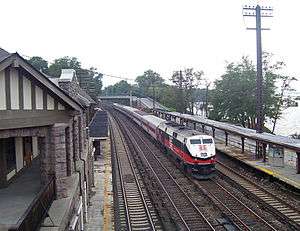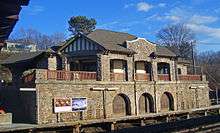Philipse Manor (Metro-North station)
Philipse Manor | ||||||||||||||||||||||||||
|---|---|---|---|---|---|---|---|---|---|---|---|---|---|---|---|---|---|---|---|---|---|---|---|---|---|---|
 A north-bound express train passes through the station | ||||||||||||||||||||||||||
| Location |
78 Riverside Drive & 270 Millard Avenue Sleepy Hollow, NY, 10591 | |||||||||||||||||||||||||
| Coordinates | 41°5′41″N 73°52′10″W / 41.09472°N 73.86944°W | |||||||||||||||||||||||||
| Line(s) | ||||||||||||||||||||||||||
| Platforms | 2 side platforms | |||||||||||||||||||||||||
| Tracks | 4 | |||||||||||||||||||||||||
| Construction | ||||||||||||||||||||||||||
| Parking |
PMIA permit West Side Village of SH on East Side | |||||||||||||||||||||||||
| Other information | ||||||||||||||||||||||||||
| Fare zone | 5 | |||||||||||||||||||||||||
| History | ||||||||||||||||||||||||||
| Opened | 1910[1] | |||||||||||||||||||||||||
| Electrified | 700V (DC) third rail | |||||||||||||||||||||||||
| Services | ||||||||||||||||||||||||||
| ||||||||||||||||||||||||||
|
Philipse Manor Railroad Station | ||||||||||||||||||||||||||
  | ||||||||||||||||||||||||||
| Coordinates | 41°5′41″N 73°52′10″W / 41.09472°N 73.86944°WCoordinates: 41°5′41″N 73°52′10″W / 41.09472°N 73.86944°W | |||||||||||||||||||||||||
| Area | less than one acre | |||||||||||||||||||||||||
| Architectural style | Tudor revival | |||||||||||||||||||||||||
| NRHP Reference # | 91000237[2] | |||||||||||||||||||||||||
| Added to NRHP | March 14, 1991 | |||||||||||||||||||||||||
The Philipse Manor Metro-North Railroad station serves residents of Sleepy Hollow, New York, United States, via the Hudson Line. Trains leave for New York City every 25 to 35 minutes on weekdays. It is 25.7 miles from Grand Central Terminal and travel time to Grand Central is as little as 38 minutes, with some local trains taking 57 minutes. Trains of electric multiple units serve the station.
Built around 1910, the Tudorbethan architecture of the station's original has earned it a listing on the National Register of Historic Places as an intact example of an early commuter rail station.[1] It is the only station on the Hudson Line besides Poughkeepsie to be so recognized.
Station
The main building (now not used for rail purposes) is a one-story hip-roofed octagonal structure of rock-faced granite block with stone, stucco and wood trim. It is built into the bluff created when the tracks were cut, and thus access to them was provided through the basement, through doors which have since been bricked off.[1]
The station's east facade is augmented with two gabled portes-cocheres projecting at oblique angles, each supported by a heavy granite pier. Trapezoidal wings also jut from the narrow sides of the octagon. The loggia across the facade has central round arched opening with a parapet. This does not lead to an entrance, instead backing the fireplace and its corbeled stone chimney. The roof original used slate, but this has been replaced with asphalt shingles.[1]
Inside, the fireplace uses several colors of granite, flanked with original iron radiators. It is complemented by dark oak matchboards over the stucco, laid to simulate paneling and form a dado. Further ornamentation includes a double frieze at ceiling level.[1]
The more modern station subsequently built by the Metropolitan Transportation Authority (MTA) consists of two long concrete, elevated side platforms with dark-green painted steel shelters. Between them are the four tracks of this section of the Hudson Line, all with third rails. The inside tracks carry express trains, and diesel-powered Amtrak and Metro-North trains bound for the non-electrified sections between Croton–Harmon and the northern end of the line at Poughkeepsie, none of which stop at Philipse Manor. A green overpass connects the two platforms.
History
The construction of the Hudson River Railroad and its later acquisition by the New York Central in the late 19th century opened up the river towns in Westchester County for suburbanization. It became possible for those of sufficient means to live in large houses amid the pastoral and scenic riverside, and accordingly villages like Irvington, Tarrytown and North Tarrytown (today's Sleepy Hollow) began to grow and develop.[1]

Undeveloped areas along the railroad line were soon snapped up by developers who saw the possibilities. In 1900 one, John Brisben Walker, acquired the old Kingsland estate in the north of North Tarrytown and began subdividing it. One of his selling points was the rail access, but this failed to materialize and Walker had to sell the property, now called Philipse Manor in a confused reference to nearby Philipsburg Manor House,[3] and had to sell to William Bell, who was able to complete it. He made the rail service possible by building the station and presenting it to the railroad.[1]
It remained in use throughout the private ownership of the railroad. When the Metropolitan Transportation Authority assumed passenger commuter operations of the then-bankrupt Penn Central in the early 1970s and passed it along to Metro-North in 1983, it eventually closed the station house in favor of automated ticketing operations, and the main house fell into disrepair. The station has since been reused as the Hudson Valley Writers' Center, which won an award from the Preservation League of New York State for its work on the station in 2005.[4]
As of 2008 the MTA has been working to extend the platforms to accommodate eight-car trains and improve service and capacity. It is part of a $56 million program focused on all the Rivertowns stations. The agency expects it will be complete by 2010.[5]
Platforms and tracks
| 4 | ■ Hudson Line | for Grand Central |
| 2 | ■ Hudson Line | no stop |
| ■ Empire Service | no stop | |
| 1 | ■ Hudson Line | no stop |
| ■ Empire Service | no stop | |
| 3 | ■ Hudson Line | for Poughkeepsie |
The station has two high-level side platforms, each eight cars long. The west platform next to Track 4 is generally used by southbound trains. The east platform next to Track 3 is generally used by northbound trains.
The Hudson Line has four tracks. The two inner tracks not next to either platform are used by express trains.
Nearby
A short drive from the train station are these interesting sites:
- Kingsland Point Park
- Phelps Memorial Hospital
- Philips Manor Restoration
- Kykuit (Rockefeller Family Estate)
- Rockwood Hall Park
- Sleepy Hollow Cemetery
- The Old Dutch Church
- The old bridge at Sleepy Hollow
See also
References
- 1 2 3 4 5 6 7 Kuhn, Robert (January 1991). "National Register of Historic Places nomination, Philipse Manor Railroad Station". New York State Office of Parks, Recreation and Historic Preservation. Retrieved 2008-06-22.
- ↑ Westchester County Listings -- National Register of Historic Places
- ↑ The actual Philipse Manor is in Yonkers, some ten miles (16 km) to the south (both manor houses served the original Philipsburg Manor).
- ↑ "EXCELLENCE IN PRESERVATION AWARD WINNERS ANNOUNCED: Restoration of Philipse Manor Railroad Station to be Honored" (Press release). Preservation League of New York State. 2005-08-02. Retrieved 2008-06-22.
Erected between 1910 and 1912, this handsome granite edifice became the gateway for one of the nation’s first (1903) planned suburban developments, Philipse Manor. In the 1970s, MetroNorth ceased using the building, and its great fireplace and American Chestnut-paneled waiting room fell victim to vandals. The HVWC successfully restored the majestic building as a space for offices, prose and poetry readings, writing workshops and other cultural programs.
- ↑ Valenti, Ken (2008-06-20). "Metro-North finishes work on four Hudson Line stations". The Journal News. Gannett Corporation. Retrieved 2008-06-22.
Work continues at three more stations - Ossining, Scarborough and Philipse Manor - which the railroad expects to complete in 2010. One other station remains, in Tarrytown, which needs extensive work, officials said.
External links
| Wikimedia Commons has media related to Philipse Manor (Metro-North station). |
- Metro-North Railroad - Philipse Manor
- List of upcoming train departure times and track assignments from MTA
- Philipse Manor Metro-North Station (TheSubwayNut)
- Entrance from Google Maps Street View

